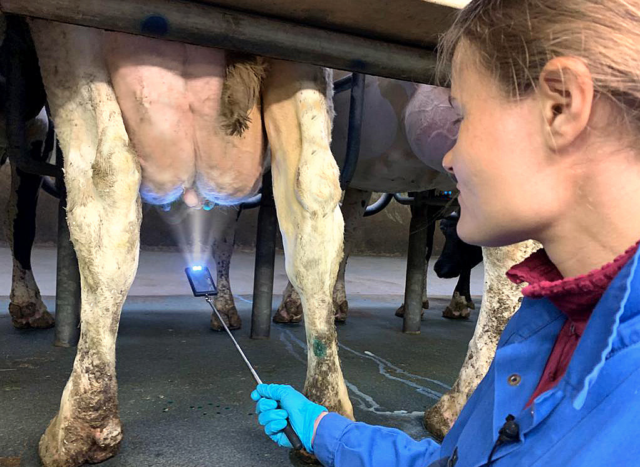
Intra Repiderma – the green standard
Udder cleft issues like udder cleft dermatitis or foul udder are often located between the front teats and at the transition of the front quarters and the abdominal wall. Although this condition is well known in the dairy industry, not much research has been performed. Udder cleft skin problems are mostly diagnosed during milking or hoof trimming and is more frequently seen in older cows regardless of stage of lactation.
The consequences of udder skin issues are impaired animal welfare, reduced milk production and affected milk quality. Also, it can lead to premature culling. It is seen on 80% of the Dutch dairy farms, of which herd prevalence from 22% up to 51% have been reported. The number of udder skin issues on a farm is often underestimated. A high milk yield, digital dermatitis (DD), mange, mastitis and the conformation of the udder are suggested as risk factors.
Current prevention options are limited
Scientific research into treatment options for udder cleft problems in dairy cows is limited. Nevertheless, several scientific studies on the treatment of the bovine hoof and skin disorder DD have been published. Treatment with Intra Hoof-fit Gel, Intra Repiderma and Spray from Intracare has been proven successful several times, reporting a success rate of acute DD-lesions of 92.0, 86.8 and 79.0% (Holzhauer, 2011; Dotinga, 2017; Jacobs, 2018, respectively). As these products showed effectiveness on hoof and skin issues, they were considered to also have potential for the treatment of udder cleft skin issues, also taking into consideration that a spray is easy to use, even upside down.
Farm and study characteristics
The study was carried out on a Dutch dairy farm with approximately 250 pure Holstein Frisian cows located in the south of The Netherlands. The study was performed from April to June 2020 and lasted 12 weeks. The cows were housed indoors in cubicles the whole year round. First- and second parity cows were housed separately from the older cows. The cubicles were covered with matrasses, lime powder and sawdust and cleaned out twice a day. Cows were milked twice a day in a conventional milking parlor. The average production level was 11,000 kg of milk/cow-year and the bulk milk somatic cell count varied between 95,000 and 162,000 cells/mL in the last 12 months.
Classification
The study was focused on score 0: a healthy udder and score 1: a mild UCD-lesion with erythema, transudate, crust or scabs and intact skin. All lactating cows were examined weekly for the presence and severity of these issues. The examination was performed in the milking parlor during milking, using a telescopic inspection mirror with lighting (Figure 1A). All data was collected by the same researcher (Jessie Hesseling, veterinarian in training at University of Utrecht) during the entire study period of 12 weeks, avoiding any inter-observer variation. The udder area was first carefully cleaned and dried with a towel, then covered with Intra Repiderma (Figure 1B). Cows with score 1 were treated every other day (Figure 1C). New cases found during the study period were included in the protocol as described above.

Assessment of improvement and recovery
The data was analyzed for the time in weeks to first improvement and recovery. At the start of the study, 42 cows of 262 examined cows had udder cleft issues and were thus selected. During the study period of 12 weeks, the average incidence decreased from 17.8% to 9.6% on this professional farm.
During the study, 22 cases were assessed at least six times and included in the analysis to determine the time to first improvement (from score 1 to 0) and time to full recovery (Table 1).

Of the 22 animals with UCD-score 1, 18 (81.8%) animals experienced complete recovery (score 0) of the udder skin, with a median time to this observation of 4 weeks (range 1-11 weeks). One spray can of Intra Repiderma is needed per 4 cows for an average of 4 weeks of use according to the protocol.
Early detection and prevention are of utmost importance
This is the first large-scale study that demonstrates the positive effect of the non-antibiotic Intra Repiderma spray on mild udder skin issues. Spraying of the mild udder skin cases (score 1) every 2 days resulted in 81.8% full skin recovery with a median time for recovery of 4 weeks.


PhD


















